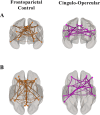Cingulo-opercular and frontoparietal control network connectivity and executive functioning in older adults
- PMID: 34950997
- PMCID: PMC9135913
- DOI: 10.1007/s11357-021-00503-1
Cingulo-opercular and frontoparietal control network connectivity and executive functioning in older adults
Abstract
Executive function is a cognitive domain that typically declines in non-pathological aging. Two cognitive control networks that are vulnerable to aging-the cingulo-opercular (CON) and fronto-parietal control (FPCN) networks-play a role in various aspects of executive functioning. However, it is unclear how communication within these networks at rest relates to executive function subcomponents in older adults. This study examines the associations between CON and FPCN connectivity and executive function performance in 274 older adults across working memory, inhibition, and set-shifting tasks. Average CON connectivity was associated with better working memory, inhibition, and set-shifting performance, while average FPCN connectivity was associated solely with working memory. CON region of interest analyses revealed significant connections with classical hub regions (i.e., anterior cingulate and anterior insula) for each task, language regions for verbal working memory, right hemisphere dominance for inhibitory control, and widespread network connections for set-shifting. FPCN region of interest analyses revealed largely right hemisphere fronto-parietal connections important for working memory and a few temporal lobe connections for set-shifting. These findings characterize differential brain-behavior relationships between cognitive control networks and executive function in aging. Future research should target these networks for intervention to potentially attenuate executive function decline in older adults.
Keywords: Cognitive aging; Executive function; Imaging; Resting-state networks.
© 2021. The Author(s), under exclusive licence to American Aging Association.
Conflict of interest statement
The authors declare no competing interests.
Figures



References
Publication types
MeSH terms
Grants and funding
LinkOut - more resources
Full Text Sources

